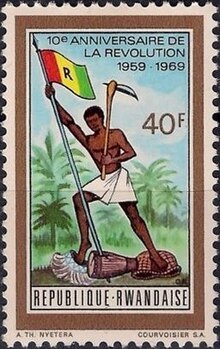
Back الثورة الرواندية Arabic Revolució ruandesa Catalan Rwanda revolutsioon Estonian Ruandan sisällissota (1959–1961) Finnish Révolution rwandaise French Revolusi Rwanda ID 르완다 혁명 Korean د روانډا انقلاب Pashto/Pushto Revolução Ruandesa Portuguese Социальная революция в Руанде Russian

The Rwandan Revolution, also known as the Hutu Revolution, Social Revolution, or Wind of Destruction[1] (Kinyarwanda: muyaga),[2] was a period of ethnic violence in Rwanda from 1959 to 1961 between the Hutu and the Tutsi, two of the three ethnic groups in Rwanda. The revolution saw the country transition from a Tutsi monarchy under Belgian colonial authority to an independent Hutu-dominated republic.
Rwanda had been ruled by a Tutsi monarchy since at least the 18th century, with entrenched pro-Tutsi and anti-Hutu policies. Germany and Belgium successively controlled Rwanda through the early 20th century, with both European nations ruling through the kings and perpetuating a pro-Tutsi policy. After 1945, a Hutu counter-elite developed, leading to the deterioration of relations between the groups. The Tutsi leadership agitated for speedy independence to cement their power, and the Hutu elite called for the transfer of power from Tutsi to Hutu, a stance increasingly supported by the Catholic Church and the colonial government.
The revolution began in November 1959, with a series of riots and arson attacks on Tutsi homes following the attack of one of the few Hutu sub-chiefs, Dominique Mbonyumutwa, by Tutsi extremists. Violence quickly spread throughout the country. The king and Tutsi politicians attempted a counterattack to seize power and ostracise the Hutu and the Belgians but were thwarted by Belgian colonel Guy Logiest, who was brought in by the colonial governor. Logiest reestablished law and order, beginning a programme to promote and protect the Hutu elite. The Belgians then replaced many Tutsi chiefs and sub-chiefs with Hutu, consigning King Kigeli V to figurehead status; Kigeli later fled the country. Despite continued anti-Tutsi violence, Belgium organized local elections in mid-1960. Hutu parties gained control of nearly all communes, effectively ending the revolution. Logiest and Hutu leader Grégoire Kayibanda declared Rwanda an autonomous republic in 1961, and the country became independent in 1962.
The revolution caused at least 336,000 Tutsi to flee to neighbouring countries, where they lived as refugees. Although the exiles agitated for an immediate return to Rwanda, they were split between those seeking negotiation and those wishing to overthrow the new regime. Some exiles formed armed groups (called inyenzi, or "cockroaches", by the Hutu government), who launched attacks into Rwanda. The largest occurred in late 1963, when a surprise attack approached Kigali. The government fought back, defeating the rebels and killing thousands of the remaining Tutsi in Rwanda. No further threat was posed by the refugees until the 1990s, when a civil war initiated by the Tutsi-refugee Rwandan Patriotic Front (RPF) forced the Hutu government into negotiations. This led to a rise in Hutu extremism and the 1994 genocide, in which over 500,000 Tutsi were killed before the RPF took control.
- ^ Gourevitch 2000, p. 59.
- ^ Prunier 1999, p. 41.
© MMXXIII Rich X Search. We shall prevail. All rights reserved. Rich X Search